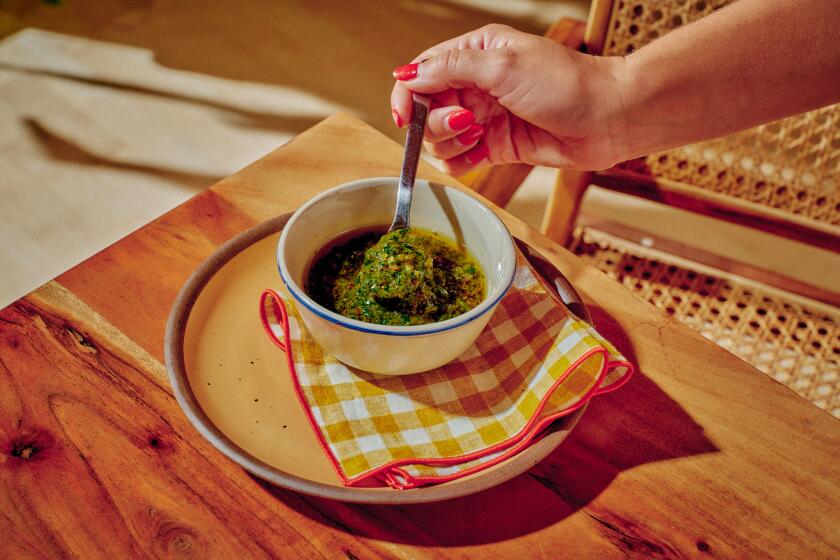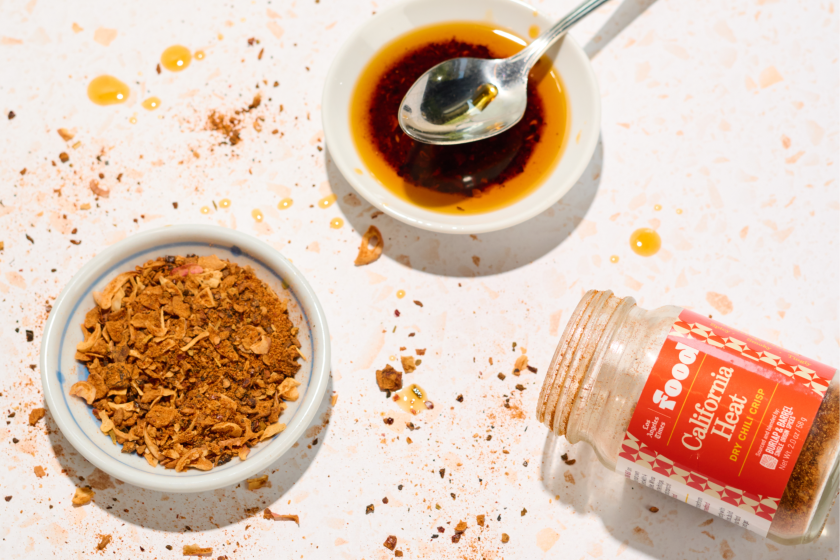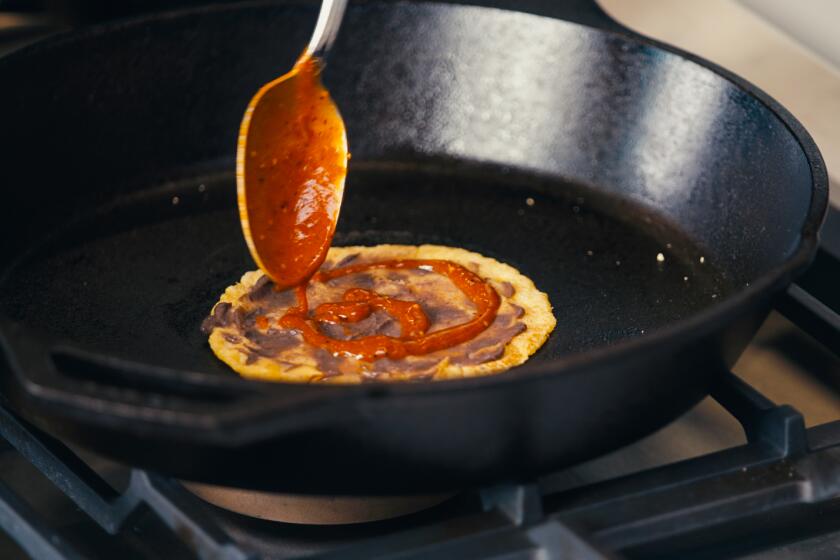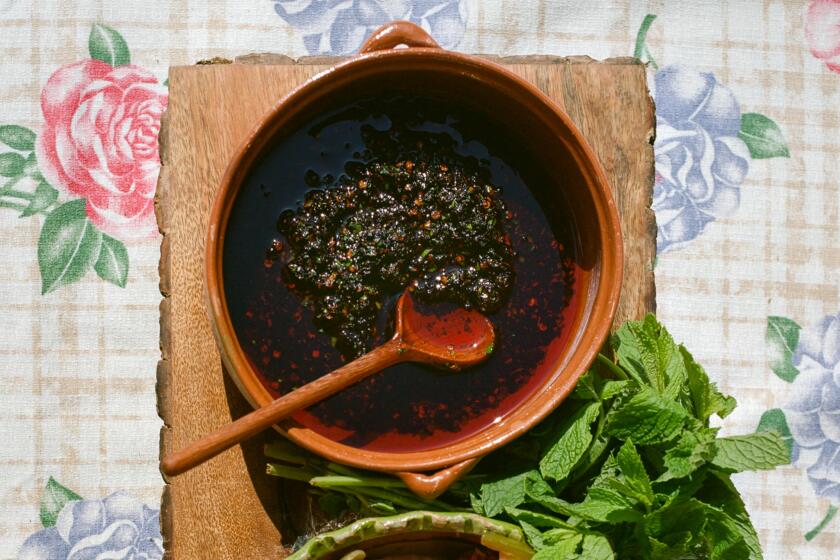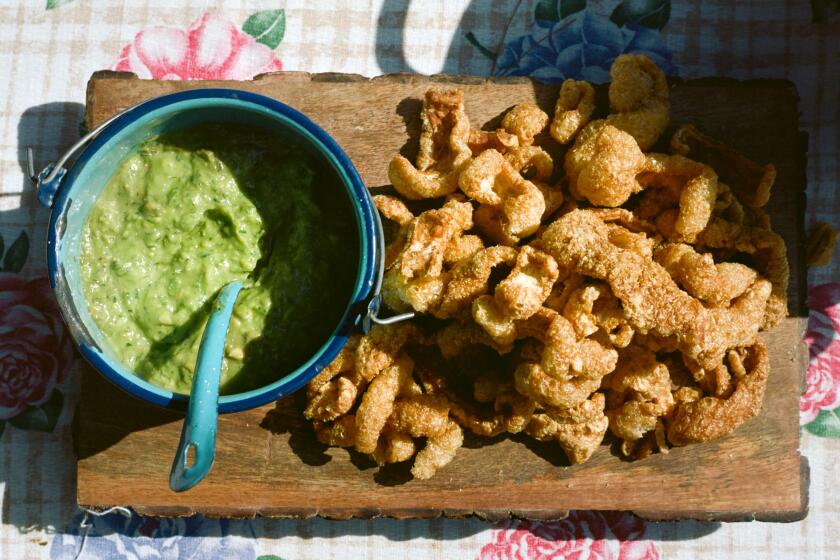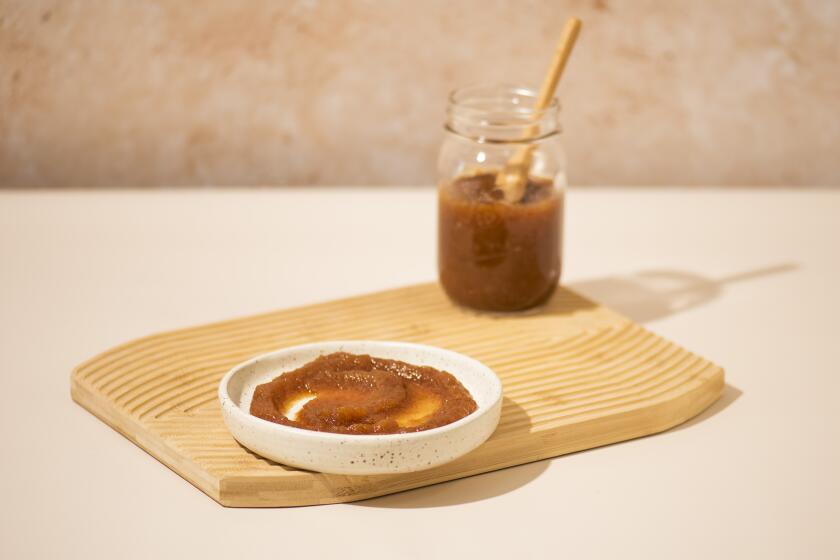Salsa verde

- Share via
When Luciano and Pauline Zamboni retired to their 100-year-old Victorian on a bluff overlooking an isolated stretch of the Mendocino coast, they probably never dreamed their lives would be taken over by dinner parties.
In the first place, it’s almost an hour’s drive to the nearest grocery store. A decent provisioning, the kind they took for granted when they lived in Southern California, requires an overnight trip to the Bay Area. Then there’s the matter of dinner guests -- the nearest town is Manchester, population 223, and it’s a couple of miles away. The next closest is Elk, population 165.
But when Luciano Zamboni is in the kitchen, all obstacles are minor.
No ingredients? Plant vegetable gardens and raise poultry, sheep and goats. Travel if you need to. The only place he even considers buying veal is his old Gelson’s in Century City, so he brings some back once a month or so.
No guests? Convert your home into an inn and supply your own.
And so 10 years after “retiring” to this isolated stretch of coastline -- he was a fertility specialist and is a professor emeritus on the medical faculty at UCLA, she was an urban planner and the school’s director of special projects -- the Zambonis find themselves serving breakfast and dinner for up to 16 guests four days a week. They are booked solid several months in advance.
The response has been so enthusiastic that in the 2003 Zagat survey, their Inn at Victorian Gardens had the highest rating of any restaurant in the Bay Area (with an asterisk acknowledging that it had drawn far fewer respondents than, say, Chez Panisse Cafe). The restaurant rated 29 for food and a perfect 30 points on service (a real credit to Pauline, who is the only waitress).
In 2004 it fell slightly, to 27 for food, the same as Chez Panisse and just behind Gary Danko, the French Laundry, Masa’s and La Toque. Which is not to say that Victorian Gardens could ever be confused with any of those restaurants.
In fact, the very suggestion would be enough to send Luciano sputtering with indignation. His culinary sensibilities are, shall we say, conservative. He constantly threatens to write an “anti-cookbook” (the working title is “Would You Please Spare Us Another Cookbook”), the gist of which, apparently, would be how much he hates anything having to do with restaurant cooking as it is currently practiced in this country.
Rather than a state-of-the-art culinary adventure complete with foams, foie gras torchons and tastings of exotic salts, dinner at the Zambonis’ is much more like a meal at the country home of a wealthy Roman, albeit one who lives in a perfectly restored Victorian farmhouse overlooking one of the wildest and most beautiful parts of the Pacific Coast.
An easy mix of ancient, modern
You approach the house on a dirt road that winds up the bluff from Highway 1. Look closely and you’ll spot the natural spring where calla lilies bloom and where Pauline goes to pick wild watercress for salads (other times she’ll use miner’s lettuce from the meadows).
The house itself is a white clapboard. Ring the bell and, when you enter the main hallway, the first impression is that everything is perfectly in its place without seeming to be self-consciously arranged. Just as in Italy, ancient and modern are comfortably juxtaposed. A gorgeous Japanese wedding kimono hangs in one hallway; in the sitting room there is a curio cabinet filled with Etruscan artifacts unearthed during construction projects in Rome that Luciano’s father supervised.
If you’re staying the night, go upstairs to the bedrooms, all of which are spacious and appointed with Italian linens. Particularly notice the floors, which are of old fir. When Pauline couldn’t find boards to match the ones that needed to be replaced, she searched out a woodworker in Humboldt County who milled new ones using 100-year-old tools to get a perfect match.
Downstairs, wander into the massive kitchen to see how Luciano is faring with dinner preparations. The Zamboni kitchen is a marvel, built around a 58-inch Wolf range. On either side, Luciano has organized a series of perfectly graduated cast-iron frying pans and a couple of dozen copper saucepans.
There’s an old fireplace along one wall, and above the long black granite work counter hangs a series of five Andy Warhol Campbell’s soup can lithographs that Luciano bought in the ‘60s.
If you’re lucky, he may be pulling a little pizza bianca out of the oven -- nothing more than pizza dough spread into a sheet pan and brushed with fragrant olive oil both before and after baking. It is warm and sharp with a sprinkling of sea salt.
There will probably be some wine as well, nothing fancy, maybe a Rosso Conero or a light white such as Pinot Grigio. Being Roman, he seems to prefer wines that are friendly rather than intellectual. With main courses, he likes a nice Lambrusco.
While he works on dinner, Luciano holds court. He is short and sturdily built and is usually dressed in bluejeans and a T-shirt, maybe the one from “Car Talk,” the hilarious National Public Radio show starring “Click and Clack, the Tappet Brothers.”
Zamboni was born and raised in Rome. “I am a romano di Roma,” he says, differentiating himself from those who moved to the city from other places in Italy. “I am so Roman that when my mother was born, the first thing she saw was the Colosseum. Her hospital was right next door.”
You get the feeling that maybe that herd of sheep out back is there mainly to supply his Roman lust for springtime abbacchio -- milk-fed lamb.
“If you don’t serve abbacchio at Easter, you’re not Roman,” he says. “You’re not even Christian.”
For a special occasion he’ll roast a baby lamb, tender and moist and perfumed with garlic and rosemary.
“This is the same lamb we eat in Rome. The type of grass that grows here is very similar to the grass that grows in Rome.
“You know, frequently in Rome you’ll be served abbacchio and you can tell that you’re really getting lamb from the Abruzzo. It can be the same age, but the grass is different, and the lamb from Abruzzo stinks like mutton. So you call the waiter over and say, ‘Why did you tell me this was abbacchio when it comes from Abruzzo?’ ”
To go with it, he serves roast potatoes, crisp on the outside and melting on the inside. This preparation, he says, is “the natural death of a potato.”
On the other hand, if the weather is right, maybe dinner will be a traditional bollito misto, an Italian ancestor of the traditional New England boiled dinner, made of long-simmered meats and vegetables.
This version starts with a first course of stracciatella, a fragrant soup made by thickening the cooking liquid with eggs and semolina.
Then comes the main course: brisket, veal shanks, oxtails and chicken breasts as well as a nice, fatty cotechino sausage. This is served carved on a platter along with the vegetables that were cooked alongside.
The final grace note is supplied by an array of accompaniments including sweet-hot mostarda di Cremona (made by candying winter fruit in a syrup pungent with mustard oil) and Luciano’s special salsa verde, a piquant pesto-type sauce made with parsley, anchovies and capers.
The idea is that you take a little of each kind of meat and each kind of vegetable, then choose among the condiments, using their sharp flavors to underline the rich, soft flavors of the boiled foods.
If Luciano is making pasta, it might be the special tonnarelli alla chitarra, made on a “guitar” he brought back from Italy -- basically a wooden box set with steel strings that cut fresh pasta into strands that are square in cross section and chewy. He likes to serve this with a sauce of mushrooms, peas and pancetta.
A menagerie shares the land
Take a break for a walk out back. The place sits on 92 acres. Local old-timers might remember it as the Caughey sheep ranch. The first house here was built in 1860. A new one was constructed in 1870, and when it burned, this one was built. The Zambonis bought it in 1990 and spent almost five years renovating it.
These days, sheep have to share the property. Pauline is an animal lover, and there are chicken houses with Araucana and Polish Banties for breakfast eggs, as well as guinea fowl, pheasants, ducks and doves. On a distant hillside goats are grazing. And a family of burros seems to have the run of the place.
There is a vegetable garden as well, a series of raised beds that are productive even in the winter. Various colors of chard sprout from one. In another are stalky cardoons, bound in paper to blanch the stems and keep them delicate. In the greenhouse, tomatoes grown from seeds brought back from Italy are still ripening, though ever so slowly given the gray, chilly climate.
Still more ingredients are brought by friends. Because Zamboni’s cooking is well known up and down the coast, there are frequent gifts of found food: chanterelles and boletes (porcini) from the woods; mussels, sea snails and even octopus collected from the rocks at Irish Beach not far away. To accommodate the local king salmon, Zamboni searched out an antique 36-inch fish poacher (the legal minimum catch here is 34 inches).
Come on the right day and maybe there will even be suckling pig: One of Zamboni’s friends raises them.
Communal dining, friendly hosts
Dinner is served at a communal table or, if a guest prefers, individually. The menu card arrives first, hand-printed on heavy paper Zamboni orders from Florence. The dining room wallpaper is a silk-screened William Morris pattern from Bradbury & Bradbury; the china is Ginori; the silver is old Buccellati from Luciano’s family.
If the occasion is right, the Zambonis will join the communal table. Luciano is opinionated and voluble. Pauline seems only slightly less so, though when her husband is on a roll, her main function seems to be shaking her head and muttering “Oh, Luciano!”
They are the most hospitable of hosts, at least once you’ve gained access. That’s not all that easy. Among the many things Luciano can’t stand are computers in general and the Internet in particular. (“Every time someone brings out a new piece of software, I celebrate by buying another fountain pen,” he’s fond of saying.)
The Inn does have a website. The site is very poetic and beautiful and, it must be said, next to useless. Basically the only practical purpose it serves is to provide the phone number.
And even once you’ve obtained that, you need to proceed carefully.
Old-fashioned courtesy is valued at Victorian Gardens. Take the time to introduce yourself and say hello. People with no time for pleasantries are likely to get hung up on.
Luciano loves to tell the story of the woman who called asking about having a wedding at the place. (The Zambonis do a half-dozen or so a year, for groups of up to 185.) Without so much as a how-do-you-do, she began rattling off a checklist of questions about the facilities. Were there televisions in the rooms? (No.) Telephones? (No, and cellphones don’t work here either.) Did the place have high-speed Internet access?
He smiles at the memory. “At that point I told her, ‘Lady, I wouldn’t do your wedding for a million bucks’ and hung up the phone.”
It is, after all, his dinner party. And as he says, “We got this place because I wanted to cook, not because we wanted to be innkeepers.”
In a small bowl combine the bread pieces with the red wine vinegar. After the bread soaks up the vinegar, mash it into a paste.
Place the bread paste, garlic, anchovies, capers, cornichons, parsley and hard-boiled egg on a cutting board. Chop fine. Transfer the mixture to a mixing bowl, stir to combine thoroughly. Add freshly ground pepper to taste. (Do not salt.)
Add the olive oil a little at a time, stirring until the salsa takes on the consistency of a pesto. Refrigerate until ready to use. Makes 1 cup.
Get our Cooking newsletter.
Your roundup of inspiring recipes and kitchen tricks.
You may occasionally receive promotional content from the Los Angeles Times.











